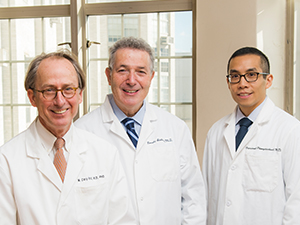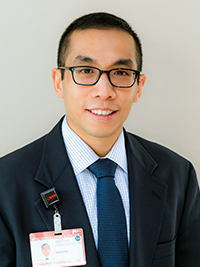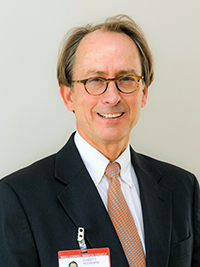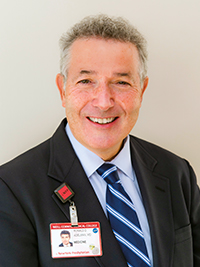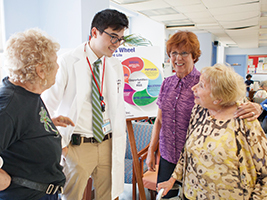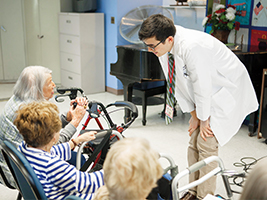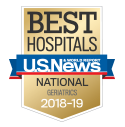|
||||||||||||||||||||||||||||||||||||||||||||
Weill Cornell Study Looks at In the evolution of the hospice movement over the last 45 years, there has been a dramatic shift away from inpatient, institutional hospice care to home-based care. While a majority of hospice patients are treated successfully at home, studies have shown that as much as 25 percent of patients who disenroll from hospice are hospitalized. Given that the majority of hospice patients who become hospitalized reenroll back into the program, these care transitions can be burdensome for patients and families and lead to poor patient outcomes. “People go into home hospice, but very often a significant proportion of them are hospitalized after being on hospice,” says Ronald D. Adelman, MD, Co-Chief, Division of Geriatrics and Palliative Medicine, NewYork-Presbyterian/Weill Cornell Medical Center. “To further identify the needs of hospice patients and to anticipate the concerns of caregivers, our Division has collaborated with Visiting Nurse Service of New York Hospice and Palliative Care to investigate the barriers and challenges to home hospice and then develop systems that are most useful for patients and their families.” Veerawat Phongtankuel, MD, who joined the Division of Geriatrics and Palliative Medicine after completing his geriatric medicine fellowship there, has served as lead investigator on two qualitative studies examining patient disenrollment from home hospice. Dr. Phongtankuel first became interested in the field during his medicine residency. “One night I was paged about an admission of a patient receiving home hospice care,” he says. “She was lying on a stretcher in the ER at two in the morning. She appeared comfortable and I wasn’t quite sure why she was brought to the hospital. My initial thought was how could we prevent a patient, who did not seem to be suffering but was in the ER, from coming into the hospital and possibly care for her at home and reduce unnecessary and burdensome care transitions?” During his fellowship, Dr. Phongtankuel learned more about home hospice and the risk factors that can lead a patient or caregiver to call 911 or for a patient to return to the hospital. This interest led to the development of the research studies with VNSNY Hospice and Palliative Care to understand these triggers. VNSNY Hospice and Palliative Care is a nonprofit organization serving 850 patients at the end of life per day. They provide home hospice care along with general inpatient care at the VNSNY Haven Hospice Specialty Care Unit in Manhattan. “The Division of Geriatrics and Palliative Medicine at Weill Cornell has a long history of working with the Visiting Nurse Service that spans two decades in a variety of areas,” says M. Cary Reid, MD, PhD, Director of the Office of Geriatric Research, Division of Geriatrics and Palliative Medicine, Weill Cornell Medicine. “These studies are an excellent example of an academic institution joining forces with a community agency to address a problem that is perceived as important to both organizations. It has been a fruitful partnership that in its most recent iteration has focused on the issue of how to improve delivery of care to patients receiving hospice services.”
The Hospice Team’s Perspective The objective of the first study, the results of which were published in the January 2016 issue of the Journal of Palliative Medicine, was to understand the reasons for hospitalization among home hospice patients from the perspective of hospice interdisciplinary team (IDT) members. These included home hospice nurses, physicians, social workers, and spiritual care counselors. “These providers all work in the field, visit patients at their home, and care for them and their caregivers at a very vulnerable time in their lives,” says Dr. Phongtankuel. Seven focus groups consisting of 73 home hospice IDT members were conducted to solicit reasons for hospitalization among home hospice patients. “We asked an open-ended question of why, based on their experiences, do patients in home hospice get hospitalized,” says Dr. Phongtankuel. “We uncovered a lot of very diverse responses and were able to identify a set of common themes.” These included:
Reasons for Hospitalization Among Home Hospice Patients
“Among the findings, we learned from IDT members that many families didn’t fully understand the principles of hospice and that the goal was to try to maintain the patient’s care at home,” says Dr. Adelman. “We also found that when there was a medical concern, the caregivers would want to seek care in the hospital system from providers that had long-term relationships with the patient. And there was the sense that the caregiver burden was significant for some family members. Hospice only covers about 20 hours of home healthcare per week. Many times caregivers are left with significant care responsibilities and felt that they couldn’t provide the necessary care for their loved ones. “What is also interesting is that many home hospice providers reported a reluctance among informal caregivers to administer morphine to relieve pain and dyspnea, something that is quite a real phenomenon and unbeknownst to me until this research,” says Dr. Adelman. “Caregivers feel that if they give morphine they’re killing their relative. Instead of seeing it as providing appropriate pain relief, they see it as something that’s very dangerous and to avoid. This, in many ways, defeats the purpose.” “Hospice patients can experience poorly managed symptoms and this is often the trigger to have them come back into acute care settings,” notes Dr. Reid. “They are unable to deal with either an escalation of symptoms, which happens over time, or sometimes it is an acute escalation of what we call symptom crises.” Dr. Reid also points out that there are barriers when delivering services to home hospice patients. “Medicare does not reimburse a lot of money per person, per day for home hospice care, so we are asking these agencies to do much with relatively little money. Hospitals get reimbursed at higher rates because of the intensiveness of care and expertise that is part of that care delivery process. The reality is people have complex needs at the end of life, and in an ideal world with a lot more resources we could be doing a better job. But it’s not to say that hospices aren’t as efficient as they can be, because I think that they are given the fact that they are constrained by limited resources.” “The reasons for hospitalization in home hospice patients are multifactorial and complex,” says Dr. Phongtankuel. “We’ve identified many areas we feel we can improve upon, which include supporting and empowering caregivers to finding ways to better manage acute symptoms, but further research is needed to clarify these issues and develop viable strategies to address them.” The Caregiver’s Perspective Following the first study, Dr. Phongtankuel and his Weill Cornell colleagues undertook another investigation by interviewing the primary caregivers of 38 patients who received home hospice services from VNSNY. Semi-structured phone interviews with caregivers were conducted and data were collected regarding the events leading to hospitalization in these patients. Analysis of the study revealed four major themes contributing to hospitalization:
A majority of caregivers called 911 prior to calling for hospice. “Some responded that they panicked, it was difficult to manage someone at home, or they had symptoms that were uncontrolled,” says Dr. Phongtankuel. One caregiver recalled, “When I came home and saw my mother was having a seizure, I said we have to call 911.” Some caregivers expressed feeling uncomfortable when seeing their loved one actively dying at home. In one case, a caregiver stated that her mother stopped breathing and her sister panicked and called 911. “I think it’s harder when your loved one dies at home,” she said. “You’re right there, you’re with the person every day. Just to watch them die, it’s not a good feeling.”
“Obviously there are some cases where hospitalization is warranted, for example, if a patient has fallen, is in severe pain, and needs acute medical attention,” says Dr. Phongtankuel. “Those patients should seek more acute medical care. However, we also want to make sure that if we can prevent the hospitalization, that would be ideal for most patients and families.” Where to Go from Here Dr. Adelman suggests that perhaps additional nursing care at the beginning of home hospice might make a positive difference. “Our thinking is that maybe you put more frequent nursing care in place when the person first comes home,” he says. “You train the families about how to give medicine and how to respond to something that might be frightening. Ultimately, the idea is to find ways of teaching the home caregivers to understand what they need to do and also to put systems in place within hospice that can anticipate the needs of patients. If it’s clear and obvious that someone is having more symptoms, there are ways of getting more help into the home. There are also ways of anticipating symptom growth and development and getting someone into an inpatient hospice unit.”
“We recognize there is a need for more educational interventions for people who elect to receive home hospice care,” says Dr. Reid. “Many patients elect to receive the hospice benefit after coming out of an acute care setting. We can think of this as a kind of care transition. The issue then becomes how do you optimize it and make that transition as seamless as possible, recognizing that you’re turning the patient over to another organization or institution. How can we better educate the patients and families so that they understand fully what the future is going to be as they make this transition?” Dr. Phongtankuel is investigating other areas of hospice care as well. “We are currently analyzing Medicare hospice claims data to identify patient risk factors and healthcare utilization patterns that are associated with hospitalization,” he says. “We’re going to look at variables such as age, gender, race, ethnicity, comorbidities, regional variations in care, and non-profit and for profit hospice programs. We feel that hospice utilization – such as how many times a nurse or a physician visited a patient may be associated with whether someone gets hospitalized or not. “Almost half of patients in the U.S who die each year are in hospice,” adds Dr. Phongtankuel. “It’s becoming more common and people are more accepting of it. We’ve uncovered just some of the challenges that patients and caregivers face in the home hospice setting. It is important to bring these issues to light and innovate and improve care for these patients and family members at the end of life.”
Community Health Education Programs:
NewYork-Presbyterian continually works with community programs to promote healthier aging. One example of a mutually productive partnership is the relationship with Riverdale Senior Services (RSS), Inc., a nonprofit agency located in the northwest Bronx whose mission is to foster the physical, intellectual, social, and emotional well-being of older adults. Programs and services take place at a community facility and are designed to encourage and enable healthy and independent living. Residents and healthcare professionals from NewYork-Presbyterian/Columbia and NewYork-Presbyterian/The Allen Hospital play an important role in providing health education talks – called Chat with the Doctor – to RSS members throughout the year. Occupational therapists, nurses, and social workers also rotate through the facility as part of their educational experience. “These talks draw a significant number of our members who are generally health literate and who have a high sense of energy and attitude around wellness,” says Andria Cassidy, RN, Deputy Director and Community Health and Education Services Director at Riverdale Senior Services. “By focusing on an older population that is aging and active in the community,” says Evelyn C. Granieri, MD, MPH, MSEd, Chief, Division of Geriatric Medicine and Aging, NewYork-Presbyterian/Columbia, “programs like Riverdale Senior Services provide a novel face of geriatrics for young physicians in training, allowing them the opportunity to interact with healthy older adults and to develop unique approaches to geriatric care.” “Our collaboration with NewYork-Presbyterian has brought physicians into our facility to educate our members on all facets of healthcare,” adds Ms. Cassidy. “We very much value that partnership.”
|
||||||||||||||||||||||||||||||||||||||||||||
|
||||||||||||||||||||||||||||||||||||||||||||


